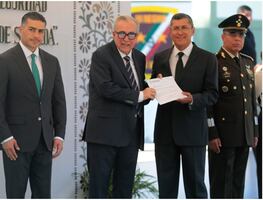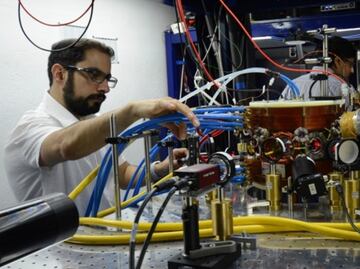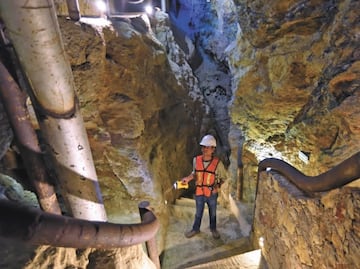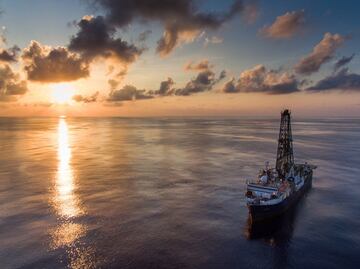Más Información

SEP debe informar sobre objetos peligrosos en revisiones escolares: Inai; violencia escolar ha ido en aumento

Videojuegos, el nuevo gancho del crimen para captar menores; los atraen con promesas de dinero y poder

“Vamos a dar apoyo a los pequeños agricultores por sequía en Sonora”; Claudia Sheinbaum instruye a Berdegué
For over 400 years, its stories were written underground. Mineral del Chico was a settlement that developed with the rise of the mining industry and “La Guadalupe” is precisely part of this heritage. It was one of the mines that were exploited for decades by the Spanish, English, and North Americans, but when the mining resources were over, it remained as a vestige of better times, shining as part of the touristic attractions of the area. Today, a scientific project seeks to add a bonus to the mine located in El Milagro River Touristic Corridor, in Hidalgo . It is LABChico , which will be the first underground laboratory in Latin America .
LABChico
will be built 100 meters deep inside a mountain, just were “La Guadalupe” is located. The project started a year ago on the initiative of the researcher from the Physics Institute of the National Autonomous University of Mexico (UNAM) , Eric Vázquez , but several researchers have joined the project with the intention to generate a multidisciplinary research project. The objective is also to involve the community of the area and to allow visitors to submerge, literally, in the science that can be done underground: from measuring low radioactivity in common materials (such as water and rocks) to observing the growth of organisms in extreme conditions .
Doctor Alexis Aguilar Arévalo
, a researcher of the Nuclear Sciences Institute , explains that this place wants to reach several goals. On one hand, it will be used to perform several research topics surrounding particle physics and astrophysics , but there is also the intention to turn it into a science dissemination center for the local population, a region that lives from tourism.
“The idea is for it to also promote an academic environment , where experts and citizens can bring materials that test our tools,” points out the expert and clarifies that they are not expecting to find dangerous radioactivity in the place. The search is directed toward implementing work techniques under the special conditions of the subsoil protected by a shield of rocks .
Underground
In an underground lab, the impact of cosmic rays on Earth’s surface is limited, which allows for more precise measurements . Under these conditions, scientists can work with tools such as a high purity germanium detector that identifies gamma radiation .
This quality has multiple functions, even measuring the amount of lead in water by detecting its radioactive isotope. As a matter of fact, this is the reason why the project was linked to research by British scientists looking for techniques available for the population to measure lead in water.
“They look to develop a mobile app to try to measure gamma rays when lead detection is perceived.” In this sense, the project is financed by the British program Global Challenges Research (GCRF) , which wants to address, through science, relevant challenges in developing countries .”
Lead is a toxic metal naturally present in the earth’s crust. Its generalized use has caused great part of the contamination of the environment with public health issues in many parts of the world. Among the main sources of this kind of environmental pollution are mining exploitation, metallurgy and, in some countries, the persistent use of paints and gasoline with lead.
The World Health Organization considers that three-quarters of the global lead consumption corresponds to the manufacture of lead-acid batteries for engine vehicles. However, this metal is also used in many other products, such as pigments, paints, glassware, jewelry, and toys . Drinking water transported in lead piping or with lead welding can also contain the toxic metal.
But it is not only about looking for polluting materials, but of knowing natural radiation in the area, for, actually, three-quarters of radioactivity in the environment comes from nature and, in that sense, not all places on Earth have the same level of radioactivity .
In some parts of India , radioactivity is really high. The reason is in thorium , a naturally radioactive element that is concentrated in some areas. The same happens in the Alps with a radioactivity level relatively high due to the composition of its granites.
Besides these variants on Earth’s natural geography, diverse human activities, such as the production of fertilizers or gas and petroleum extraction , can increase the dose of natural-origin radionuclides.
There can also be radioactivity in our homes, proceeding mainly from radon. This gas is frequently produced by the disintegration of uranium contained in rocks, but good ventilation can solve this problem. Radiation is not always a synonym to destruction . There are also elements of this kind in multiple foods and even our bodies are radiation sources, for they store small amounts of radioactive potassium, which is necessary for the human body.
Only natural radiation existing in the environment will be measured at LABChico . They look to show that it is a natural characteristic that is not dangerous as long as it is found on appropriate levels for health.
Aguilar Arévalo points out that the project is at an initial stage. Until now, other activities have been done, such as a recognition of the area that includes: a topographical survey of the area, a 3D map , and geomechanical studies of the mine that lead to the selection of “La Guadalupe” as the ideal place for a laboratory. The neighbor mine of San Antonio was a runner-up. “The problem with the latter was that we detected cavities and the best circumstances for an underground laboratory are given by better rock coverage which work as a shield against cosmic radiation.”
It is esteemed that the lab could have from 15 to 20 square meters of surface and a height of four meters , but the rest of the main tunnel will be left untouched so that touristic activity can continue without interfering with all that has been created around the mine, even the myth of the goblin that protects it and for which there is an altar at the entrance.
Beyond instrumentation and the work supplied by the different academic entities of UNAM and the new financing by GCRF , they hope the most important finance for the development of the lab to come directly from the Mexican government , and a probability in this sense could be the state funds of Hidalg o that has been very interested in the project, according to Aguilar Arévalo.
In the area, there have already been important collaborations between the touristic and scientific activity. The Autonomous University of the Hidalgo (UAEH) , the Geophysics Institute , and the Atmospheric Sciences Center of UNAM , among other university institutions, developed the H idalgo Mining Region Geopark , in collaboration with the T ourism and Culture Ministry of Hidalgo and the Science, Technology and Innovation Council of Hidalgo (CITNOVA).
World-class laboratories
“This place in Mexico will have moderate coverage, but around the world there over between 20 and 30 deep underground labs where edge research is taking place” mentions Aguilar Arévalo.
Among the examples mentioned by the expert is the Gran Sasso Laboratory in Italy . This place was built 37 years ago and it is considered the most important underground laboratory in the world, for although it does not have such a large depth as others (it is 1,400 meters from the highest peak of the Apennines), they work in three big halls with over 15 experiments.
Approximately 1,000 scientists of 25 countries work tirelessly in shifts of almost 200 people. The main menu: Nuclear astrophysics . The meals: Dark matter or the mysteries of neutrinos , the lighter particles of matter without an electric charge.
The main neutrinos observatory was located in SNOLAB. This Canadian laboratory of underground physics is 2 kilometers deep in the nickel mine Vale’s Creighton in Sudbury, Ontario . Its main experiment was precisely the study of neutrinos, the subatomic particles with such a tiny mass that they have been calculated in less than a billionth of part of the mass of a hydrogen atom.
Another example of a laboratory of this sort is the one in Jinping, China . It is the deepest lab in the world , located in the southwest of this Asian country.
Ironically, the challenge seems to be entering a deep hole to discover the secrets of outer space . The mysteries of the universe are hidden underground, and Mexico will climb a step down to get closer to another kind of knowledge .
mp











